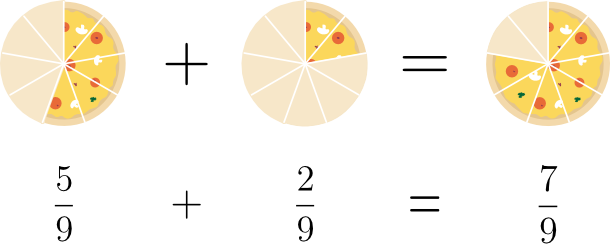- If the fractions have different denominators (bottom numbers), make them equal by renaming the fractions.
- Add the top numbers (numerators) to get the new numerator. Copy the denominator.
- Simplify the resulting fraction if possible.
Alright, let’s add some fractions using these steps. I have divided the examples into categories to make things easier to follow.
When adding fractions with the same denominator, we don’t need to worry about making them equal (the first step mentioned above). That makes it really easy to add them.
Solution
Step 1. The denominators are already the same (), so we can move to step 2.
Step 2. Add the numerators and copy the denominator.
Step 3. The fraction obtained can’t be simplified further (no common factors). So, that’s our answer.
Here’s the solution in pictures.

Solution
This time, the fraction obtained was not in its lowest terms. So, in the last step, we simplified it by dividing the top and bottom numbers by their greatest common factor, .
Very often, the fractions we want to add do not have the same bottom number. So, let’s see how to add fractions with different bottom numbers.
Solution
Step 1. When the fractions have different denominators, we need to make the denominators equal before we can proceed.
To do so, we take a common multiple of the denominators (preferably the Least Common Multiple or LCM). The LCM of and is .
Now, if we multiply the first denominator by and the other by , they will both become equal to .
But remember, when you multiply the denominator by any number, you must also multiply the numerator by the same number. Otherwise, the value of the fraction will change.
So,
Step 2. Once the denominators are equal, we add the numerators and copy the denominator.
Step 3. The fraction is already in its lowest terms. So, that’s our answer.
Denominators in a fraction tell us how many parts the whole has been divided into.
When fractions have different bottom numbers, they are referring to parts that are unequal in size. See how each slice in the first pizza is bigger than that in the other?

By making the denominators equal, we make the slices equal (without changing the quantities of pizza), so we can go ahead and add them.

Solution
Again, we must make the bottom numbers equal before we can add the top numbers.
The LCM of and is . So we multiply the top and bottom numbers of the first fraction by , and those of the second by .
So far, we have been adding fractions together. But what if we have fractions and whole numbers?
Well, one way is to write the whole number as a fraction (with one as the denominator) and then add the two fractions. But there’s also a much better way.
We’ll look at both methods in the next example.
Solution
Here we start by writing as a fraction ( over ) and then proceed as we did in the previous examples.
In the last step, I converted the improper (top-heavy) fraction into a mixed number. It wasn’t necessary but unless the question uses improper fractions, it’s preferred that you don’t leave improper fractions in your answers either. So, convert them into mixed numbers.
When adding a proper (bottom-heavy) fraction and a whole number, just put them together as a mixed number – the whole number, followed by the fraction.
Here’s how it would look in our present example.
That’s it. Unbelievably simple, right?
Solution
Let’s solve this one quickly using the smarter approach.
Done!
Important – You shouldn’t put together a whole number and an improper fraction (a top-heavy fraction) to form a mixed number. The fractional part in a mixed number should be a proper fraction.
When adding improper fractions and whole numbers, it’s generally simpler to use the conventional method.
Before we move ahead, let’s look at one more example.
Solution
Here we have more than one whole number and fraction. So we will add the whole numbers and fractions separately and then put the results together (as a mixed number) to get the final sum, as discussed above.
When adding fractions and mixed numbers, again, you have two methods to choose from. But as you’ll see in the next example, one is faster and more efficient than the other.
Solution
In this method, we convert the mixed numbers into improper fractions and then proceed to add two fractions.
Again, we convert the answer from a top-heavy fraction to a mixed number.
Okay, this is a fine method but let’s look at something better.
Split the mixed number into whole number and fraction parts and then proceed as you would to add fractions and whole numbers.
Here’s how we can solve the present example using this method,
Solution
First, we separate the whole number parts and fractional parts contained in the mixed numbers and group similar items together.
Next, we add the two groups separately and then put the results together to get the final answer.
Note - If the method appears unnecessarily lengthy here, it’s only because I am showing all the steps. Once you solve a few different problems using both methods, you will see why this one is easier, faster, and more efficient.
And with that, we come to the end of this tutorial. Until next time.
We use cookies to provide and improve our services. By using the site you agree to our use of cookies. Learn more